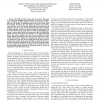21 search results - page 2 / 5 » Selective Voting - Getting More for Less in Sensor Fusion |
GECCO
2006
Springer
13 years 9 months ago
2006
Springer
Various methods for ensemble selection and classifier combination have been designed to optimize the results of ensembles of classifiers. Genetic algorithm (GA) which uses the div...
CVPR
2011
IEEE
12 years 9 months ago
2011
IEEE
Catheter tracking has become more and more important in recent interventional applications. It provides real time guidance for the physicians and can be used as motion compensated...
TSMC
2010
13 years 21 hour ago
2010
-- This paper presents an artificial ant-colony approach to distributed sensor wakeup control in wireless sensor networks (WSN) to accomplish the joint task of surveillance and tar...
IJDSN
2006
13 years 5 months ago
2006
The ability of sensor nodes to enter a low power sleep mode is very useful for extending network longevity. We show how adversary nodes can exploit clustering algorithms to ensure ...
CHI
2005
ACM
14 years 5 months ago
2005
ACM
We present a system in which a cell phone decides whether to ring by accepting votes from the others in a conversation with the called party. When a call comes in, the phone first...

